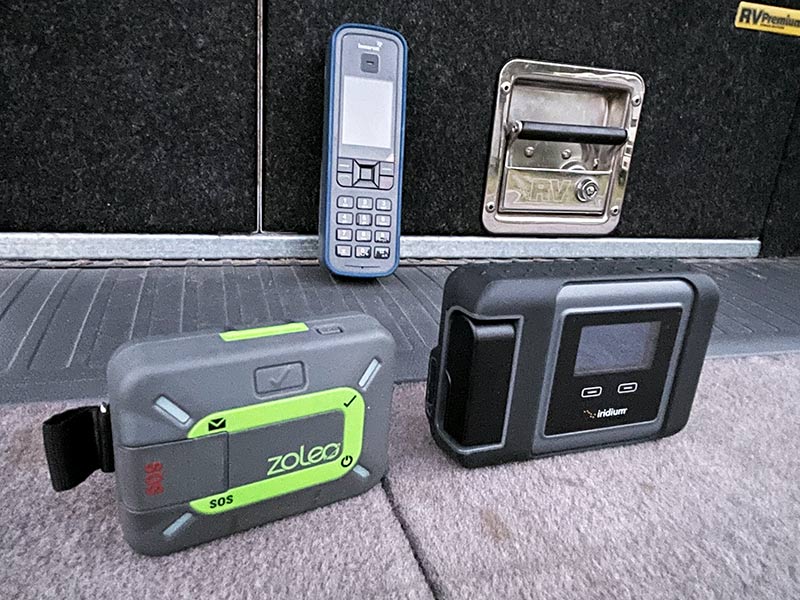It’s no secret that I’m a big fan of tech gadgets, especially when it comes to caravan and camping gear. And thanks to the SatPhone Shop, I’ve had the opportunity to try out some very cool communications equipment over the last 12 months, including the subject of this review, the Iridium GO! In many respects, this is the product I have been looking forward to testing the most. It does just about everything: voice and text-based satellite communications using a smart device as the main interface.
WHAT IS IRIDIUM GO!?

Iridium GO! is a small, self-contained device that provides an interface between your smartphone and the Iridium satellite phone network. It uses its own built-in Wi-Fi router to connect up to five smart devices at a time. To use Iridium GO!, you download two applications to your smart device and connect to its Wi-Fi network. The apps allow you to make and receive voice-based satellite phone calls, send and receive text messages, send your location data to predefined contacts and send off an SOS alert to emergency services, essentially turning your smartphone into a satellite phone.
SETTING UP
To utilise all the functions of the Iridium GO!, you will need to download the main application, Iridium GO!. There is a secondary app available called Iridium Mail and Web but it’s not essential for general everyday use. Both are available for Android or iOS. Most of the account set-up is done through the apps, with the remainder through the Iridium website. The instructions are clear and easy to follow. I certainly had no issues.
Setting up the Iridium GO! is simplicity in itself. Simply raise the inbuilt antenna and the unit powers on. You need to place the unit in a position where it has an unobstructed view of the sky. This is critical for satellite connectivity and getting the best signal, free from interruption.
I obtained the best performance by mounting the Iridium GO! on a small tripod and placing it in the most open location within the range of our caravan.
NETWORK AVAILABILITY
Iridium GO! uses the Iridium satellite phone network for all its communications. This consists of 66 active satellites in low Earth orbit. This differs from other satellite phone networks, which have as little as one satellite covering our part of the planet.

It means you should be able to access the network as long as you have a clear sky above you. I tried using Iridium GO! in a variety of locations and, as far as data communications were concerned, I never once had connection issues. It even worked perfectly from the dashboard of our car.
Voice communications required the best, most unobstructed view of the sky possible. This is due to the way the satellite system works. The satellites are constantly on the move. As one satellite moves out of view, another approaching satellite takes over the call. If you have trees overhead, heavy clouds or if you are camped in a valley, this handover from one satellite to another may be interrupted.
Fortunately, this is where the design and operation of Iridium GO! is vastly superior to a handheld satphone. With a handheld phone, you’re limited to the position where you are operating the phone and that may not be in an ideal location with a clear sky overhead.
Iridium GO!’s Wi-Fi range extends to 30m. This means you can place the unit in an ideal location within range of where you want to make calls from, which I found minimised call dropouts dramatically. It was certainly a huge improvement over our handheld satphone.
BATTERY LIFE AND RECHARGING
Iridium quotes battery life figures of 5.5 hours of talk time and 15 hours of standby time. I can’t imagine wanting to talk to anyone for five hours on a satellite call, but it was nice to know the system had that ability. I certainly had no issues making two or three 10 or 20-minute calls on a single charge of the battery.
In any case, I always recharged the unit after a day of use just to be certain I had maximum talk time available should the need arise.

Recharging times are quoted at 4.5 hours from completely flat to 100 per cent. I saw nothing in my testing that would question those times. I recharged the device from a number of sources, including a portable power pack and a BEAM Outback 11W solar USB charger. I liked using this option as it meant I could take the Iridium GO! on an extended trip off-grid and still be able to recharge the unit.
DURABILITY
One observation I made of the Iridium GO! when I first unboxed it was the unit’s apparent durability and build quality. With military-grade ruggedness (MIL-STD 810F) and ingress protection to IP-65, this thing is built to take an absolute beating. It’s hard to convey in words just how strong the unit feels. The majority of the outer casing is made from hard-wearing, rubber-coated plastic.
All ports and buttons are protected by rubber covers. The removable battery cover is held in place by two stainless steel screws. The tripod mount is stainless steel, too. Short of throwing it out of an aeroplane, I can’t see how you could damage it, even if you were in the worst outback conditions.
The unit we tested was a rental kit. It was supplied with a heavy-duty, protective carry case that held the Iridium GO! as well as all the accessories. We threw the kit in the back if the car with all our other gear and nothing was damaged. Not a single scratch.
EASE OF USE
If you have ever had to set up and use a Wi-Fi hotspot, you’ll have no issues setting up and using Iridium GO! I found it quite easy to use once I had positioned the unit with a clear sky above. I had no issues connecting to the unit within the Wi-Fi range and the only times I experienced call dropouts was when there were overhead obstructions.

At first, I thought the need to use two applications would be an inconvenience but, in reality, this was no trouble at all. Both apps are well laid-out and intuitive to use.
It was worth noting that the Twitter feature has been disabled on the app. I imagine this is because Twitter has developed into more than just a text-based service and would be beyond the bandwidth capabilities of the Iridium network.
ANY NEGATIVES?
You could say the need to have two apps to cover all the functionality of the Iridium GO! is a negative when compared to other devices, such as the ZOLEO, which has just one controlling app. You have to keep in mind this is an older product and so some development differences are inevitable. And while the Iridium GO! does allow limited data access, the speed is only 2.4kbps, so many websites and applications wouldn’t work.
FINAL IMPRESSIONS
If you’re in the market for a remote communications solution that includes the ability to make satellite voice calls, you’ll be looking at either a handheld satellite phone or the Iridium GO! Given both hardware and network access costs will be similar, in my opinion you would be better served with the Iridium GO!.
It offers more functionality than a handheld satphone and, thanks to the range of its Wi-Fi network, more flexibility. The ability to place the Iridium GO! in the best possible location for satellite network reception means you will have more reliable communications than you would have with a handheld phone.
Iridium GO! is also built tough. Seriously tough. Certainly a lot tougher than any hand-held satphone I’ve ever used. If you’re the more adventurous traveller that regularly ventures into rough outback territory, then you will appreciate the solid dependability of the Iridium Go!.





